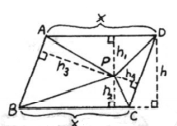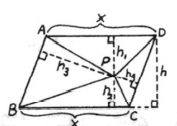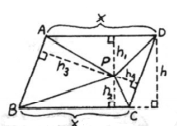
a.
To show the sum ofarea of triangleAPD and
a.
Explanation of Solution
Given:
P is any point interior of rectangle ABCD.
Formula Used:
Proof:

In rectangle, opposite sides are equal.
b.
To state whether equation formed by sum of area of triangle APD and triangle BPC is equal to sum of area of triangle APB and triangle PCDfor a parallelogram ABCD is valid.
b.
Answer to Problem 33PSC
Yes, the equation formed by sum of area of triangle APD and triangle BPC is equal to sum of area of triangle APB and triangle PCDfor a parallelogram ABCD is valid.
Explanation of Solution
Given:
P is any point interior of parallelogram ABCD.
Formula Used:
Calculation:

In parallelogram, opposite sides are congruent.
c.
To check whether equation formed by the sum of area of triangle APD and triangle BPC is equal to sum of area of triangle APB and triangle PCDfor a trapezoid ABCD is correct.
c.
Answer to Problem 33PSC
No, the equation formed by sum of area of triangle APD and triangle BPC is equal to sum of area of triangle APB and triangle PCDfor a trapezoid ABCD is not correct.
Explanation of Solution
Given:
P is any point interior of trapezoid ABCD.
Formula Used:
Calculation:

In trapezoid, opposite sides are not necessarily congruent.
Also, altitude to nonparallel sides are non collinear.
Chapter 11 Solutions
Geometry For Enjoyment And Challenge
Additional Math Textbook Solutions
Elementary Statistics: Picturing the World (7th Edition)
Introductory Statistics
Elementary Statistics (13th Edition)
Thinking Mathematically (6th Edition)
Basic Business Statistics, Student Value Edition
- Door 87.5in to 47 living 44.75 Closet 96in Window ISS.Sin 48in Train Table 96in 48in 132:2 Windowarrow_forward39 Two sides of one triangle are congruent to two sides of a second triangle, and the included angles are supplementary. The area of one triangle is 41. Can the area of the second triangle be found?arrow_forwardA parallelogram with an area of 211.41 m^2 hast a base Thatcher measures 24.3m. Find ist height.arrow_forward
 Elementary Geometry For College Students, 7eGeometryISBN:9781337614085Author:Alexander, Daniel C.; Koeberlein, Geralyn M.Publisher:Cengage,
Elementary Geometry For College Students, 7eGeometryISBN:9781337614085Author:Alexander, Daniel C.; Koeberlein, Geralyn M.Publisher:Cengage, Elementary Geometry for College StudentsGeometryISBN:9781285195698Author:Daniel C. Alexander, Geralyn M. KoeberleinPublisher:Cengage Learning
Elementary Geometry for College StudentsGeometryISBN:9781285195698Author:Daniel C. Alexander, Geralyn M. KoeberleinPublisher:Cengage Learning

